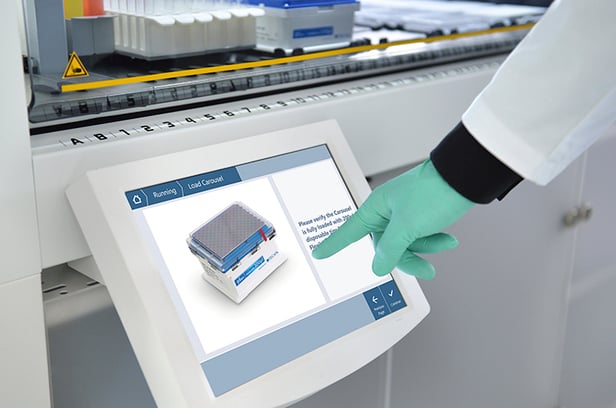By Beatrice Marg-Haufe
Written in collaboration with Zymo Research, Irvine, CA, USA.
Applications based on next-generation sequencing (NGS), and more recently third-generation sequencing, play a central and ever-growing role in disease research. There is a concurrent need for reliable, high-throughput nucleic acid purification systems to feed samples into the analysis workflow for these applications. To meet this need, laboratories must either invest in more manpower to process samples manually, or transition to a liquid handling platform that can automate the workflow in a manner appropriate for the downstream application.

FluentControl™: one great software, two powerful interfaces.
However, implementing such workflows onto a liquid handling device can be difficult and there are 3 common issues that users can experience during the process:
1. Lack of software knowledge: users need to build custom scripts (individual protocols) that are adapted for their workflow.
2. Designing a worktable: the choice of hardware is huge and confusing. How do you know which of the hundreds available is the one for you?
3. Optimizing the workflow: once a basic script is generated, a workflow can take months to complete and optimize before routine use can be assured.
These three challenges can waste months of precious lab time and effort. More importantly, if not adequately addressed they can be a major source of errors and other problems that can compromise the quality and accuracy of downstream genomics techniques and applications, such as NGS and genotyping.
Challenge #1: lack of software knowledge
Problem:
Although automation software is getting more modular and easier to use, many lab automation solutions still require a significant amount of software expertise to automate simple everyday tasks and develop custom workflows for varying applications. Imagine the delays and headaches that can arise in the lab if some level of coding or advanced training is needed every time you want to create a new nucleic acid purification (NAP) protocol or adapt an existing workflow so that it can handle a different commercial kit for NGS library prep.
Ironically, as a result of automating a protocol—particularly one involving a series of manipulations on a robot, and varying amounts of different reagents—a certain amount of human intervention may still be needed. Not only is this an inefficient use of people’s time, it also adds to your training burden and creates new potential opportunities for error.
The more complex the system is, the more software training is typically required. To make matters worse, training often has to take a back seat to the routine lab operations required to maintain sample throughput, particularly in busy clinical labs. In a world where we see an ever-increasing focus on the data-rich genomic analysis techniques that that underpin personalized medicine, throughput requirements are not going to decrease any time soon, so any steps that can take the pressure off this need for comprehensive training are going to be welcome.
Solution:
To meet the demands of today’s increasingly complex and ever-changing genomics applications, it is important to choose an automation platform that gives users the power to build and customize their own sample prep protocols easily and without extensive training. Separating method development from the management of everyday operations can greatly simplify user workflows, whilst maintaining a high degree of flexibility.
For example, Tecan has taken this approach with its FluentControl™ software and Fluent® automation workstation. The FluentControl™ software makes assay development a breeze, since it allows you to build, optimize and maintain your own protocols without the need for computer programming expertise. Universal scripts can be used in a modular way to build more complex routines. The separate Fluent automation workstation then seamlessly guides users through set-up and execution of their established protocols, providing a convenient touch screen, intuitive user interface, and visual displays that provide instant feedback on whether the work deck has been configured correctly.
By separating the everyday workflows from the configuration of new protocols, Tecan has been able to make both processes simpler and more efficient. Working in close collaboration on the hardware and reagent aspects respectively, Tecan and Zymo Research have developed optimized automation protocols for their main nucleic acid extraction workflows, for fast integration of extraction procedures into any lab.
The Fluent Gx Assurance software also streamlines workflow documentation and compliance activities, delivering a transparent audit trail with minimal manual input.
All of these features work together to make daily operation straightforward and facilitate rapid on-boarding of new operators, freeing up your software experts for more valuable tasks.
Challenge #2: designing a worktable
Problem:
In addition to software challenges, choosing the correct hardware and accessories can also cause significant delays in your automation project. Many companies have hundreds of hardware configurations and accessories from which to choose. Failure to select the correct hardware may limit your throughput, increase the number of consumables used, and extend your total run time. What if that process could be simplified, and you could be sure that you had chosen the right instrumentation and accessories before you start?
Solution:
The key is to invest in a platform that is sufficiently standardized for ease of use, but has built-in flexibility for running a large variety of existing extraction protocols. Equally important, it should support new method development, without the need to learn complex liquid-handling procedures.
A universal worktable configuration is often the best option to ensure you get the level of flexibility you need. For example, to accommodate several different extraction protocols, you may need the ability to incorporate bead-based extraction procedures, have dedicated areas for sample handling and processing, and have sufficient deck space for disposable tips.
In addition to the size and flexibility of worktable configuration, it is important to consider which features and functionalities come with the worktable operating software. A particularly useful feature is the ability to implement calculations, so that you can be sure exactly the right amount of reagent is loaded each time, according to the exact volume that is required for the sample number processed in each sample batch, avoiding waste and experimental error.
The graphical user interface (GUI) can also make a big difference when it comes to ease-of-use and error-proofing. For example, does the GUI clearly display exactly what reagents and samples need to be loaded at what location on the worktable? Can it cope with a variable number of samples?
Challenge #3: optimizing the workflow
Problem:
After a script is written and ready to go, further testing is still required to ensure that the script is functioning at a level that complies with quality and regulatory standards. Small errors in the script for DNA purification or other sample preparation processes can compromise the quality of the end product, as well as disrupt downstream applications.
Since the root cause of these issues can be hard to pinpoint, it makes sense to avoid the issue altogether by ensuring the script is rigorously tested and fully optimized before use. For reliable performance, the robot has to be able to “find” defined positions on the worktable accurately, which can require minute adjustments over all three axes (x, y, z). It is also essential to test combinations of different buffer volumes, shaking speeds, and incubation times. However, that process can take months for an applications expert to perfect.
Solution:
One way to minimize or even eliminate a lot of troubleshooting is to choose an automation platform that has been designed with genomics labs in mind, and offers pre-developed routines for common tasks. Ideally, nucleic acid extraction workflows for commonly used commercial kits should already have been pre-programmed and extensively tested, so that you don’t have to spend time optimizing the script. For example, Zymo Research and Tecan have collaborated to develop DreamPrep™ NAP, a complete walkaway solution for automated DNA extraction. This solution uses the major extraction workflows from Zymo Research and provides fully optimized nucleic acid extraction methods.
As we have seen, commercial solutions such as Fluent and the DreamPrep NAP workstation can go a long way towards eliminating three major challenges in the automation of sample prep workflows for genomics. Be sure to read the next and final article in our blog series to find out how to quantify and normalize your nucleic acid samples in a reliable and reproducible manner suitable for downstream genomics techniques and applications such as NGS and genotyping.
Acknowledgements
This blog was written in collaboration with Zymo Research, Irvine, CA, USA.
About the author

Dr Beatrice Marg-Haufe
Dr. Beatrice Marg-Haufe is a product manager at Tecan Switzerland with over 10 years of experience in assay development and product management. She studied biochemistry at the University of Bielefeld, Germany, and at Harvard Medical School, USA. She focused on cancer research during her PhD in Biochemistry at the MPI, Munich, Germany. She joined Tecan in 2009 focusing on applications for the agriculture and genomics market.











